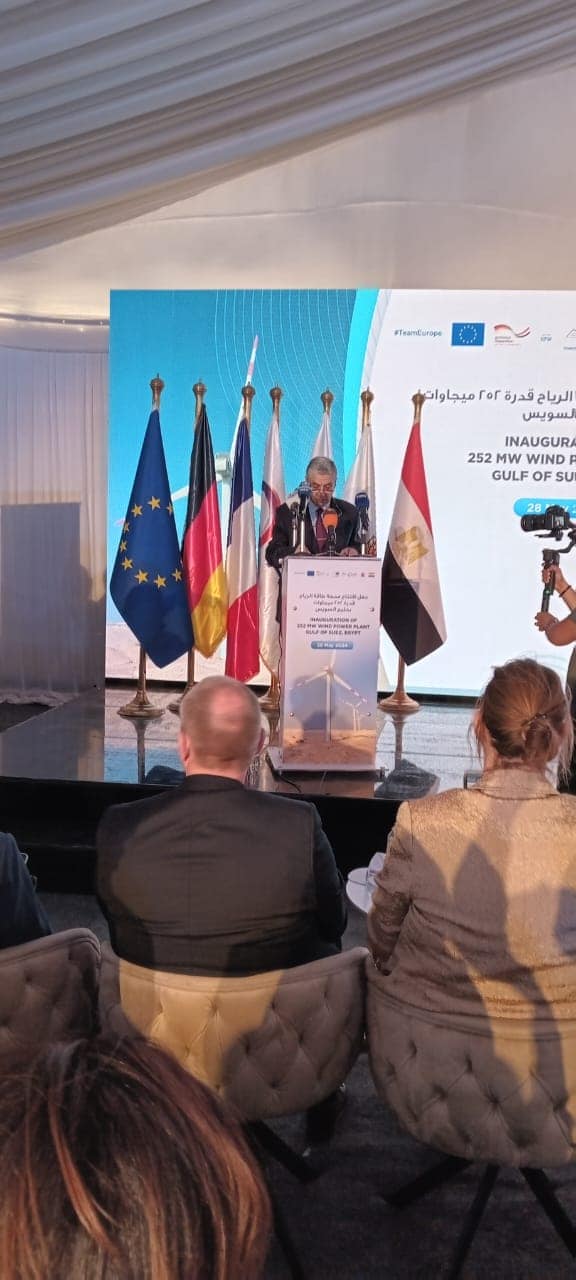Dr. Mohamed Shaker, Minister of Electricity and Renewable Energy, on behalf of His Excellency the Prime Minister, His Excellency Dr. Mostafa Madbouly, opened the ceremony.
The Gulf of Suez wind power station project, with a capacity of 252 megawatts, gave a speech during the opening ceremony, during which Shaker expressed his deep appreciation to the European partners for their continued support and cooperation.
The minister pointed out that this project is a model of fruitful cooperation between the Egyptian government and international financing institutions, especially in the field of renewable energy by providing concessional financing for green projects.
Shaker added that this project will add 252 megawatts to the network’s renewable energy capabilities, which will contribute to the production of electrical energy estimated at about 1,200 gigawatt hours annually and save the consumption of more than 200,000 tons of fossil fuels annually, thus reducing about half a million tons of carbon dioxide emissions annually.
Shaker explained that the Egyptian electricity sector began a long time ago to shift to using low-carbon electricity sources by relying primarily on exploiting renewable energy sources and contributing significantly to improving energy efficiency, securing electricity supplies, and reducing emissions.
The minister added that the integrated and sustainable energy strategy has been approved in Egypt, which includes maximizing the participation of renewable energy capabilities in the energy mix to reach about 42% in 2030, in accordance with the update of the Nationally Determined Contributions (NDC) in June 2023, and the energy strategy is currently being updated until 2040. In light of global developments and new variables that include the decline in the costs of modern technologies and the tremendous development in energy storage technology, the option of generating electricity from coal has been excluded and these planned capacities have been replaced with other renewable energy in addition to the use of green hydrogen.
Shaker explained that Egypt is rich in natural resources of wind and solar energy. In theory, Egypt has the ability to generate approximately 350 gigawatts of wind and 650 gigawatts of solar energy, and so far more than 40 thousand square kilometers have been allocated to implement renewable energy projects to generate… Up to 150 GW of
Solar energy and 120 gigawatts of wind farms.
Shaker added that many measures have been taken and incentives have been provided to encourage the private sector’s participation in renewable energy projects, based on our conviction that investments from the private sector will play a major role in achieving our goals.Shaker explained that “4” memorandums of understanding had been signed with local and international companies in the field of wind energy projects to enter the sites and conduct the required measurements and studies in order to add 28 gigawatts of wind energy based on a competitive price of 2.4 cents per kilowatt hour to purchase a kilowatt hour.
The minister added that the Egyptian electricity sector has already expanded and modernized the electricity transmission network in order to discharge energy generated from additional renewable sources, and that the Egyptian Electricity Transmission Company is working with the Belgian company Elia Grid International to study the needs of the national network to accommodate renewable energies for green hydrogen projects and determine the requirements for strengthening the network with the aim of Addressing the expected large increase in energy production from renewable sources.
The Egyptian Electricity Transmission Company is also currently cooperating with the Swedish Fund to conduct technical studies regarding reactive power planning, optimal grid management for large-scale renewable energy integration and implementation of future power purchase agreements (PPA).
The minister added that there is a close relationship between renewable energy and green hydrogen production. In this regard, many measures have been taken to develop hydrogen in Egypt.
On February 27, 2024, the Supreme Council of Energy approved the National Low-Carbon Hydrogen Strategy.
The strategy’s vision includes that “Egypt will be one of the world’s leading countries in the low-carbon hydrogen economy” and targets 5-8% of the global tradable market by 2040.
Shaker explained that it is expected that by 2040, more than 100,000 job opportunities will be created, a high percentage of which will be for highly skilled people. With proper training, many of these jobs will be received by the local workforce.
On January 27, 2024, a law was issued regarding incentives for green hydrogen production projects and its derivatives, and Shaker explained that the basic philosophy of this law is to attract serious projects by adopting some incentives.
Shaker noted that 27 memorandums of understanding had been signed with some major international developers. In addition to signing 11 partnership agreements with qualified international developers.
At the end of his speech, he expressed his thanks and appreciation to the partners and all national partners for their efforts and support to make this project a reality.


